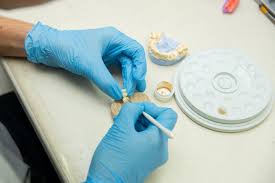Welcome to our deep dive into the transformative world of dental health, where technology meets precision care. Today, we're shedding light on a breakthrough that's been revolutionizing how dental professionals plan and execute treatments: Cone Beam Computed Tomography (CBCT). Specifically, we'll explore the integral role of CBCT in implants, from the initial planning stages all the way to the placement of the implant itself. Whether you're simply curious or considering dental implants, understanding CBCT's impact can offer valuable insights into modern dental care.
Understanding CBCT and Its Revolutionizing Role in Dental Implants
Imagine stepping into the world of dental care, where every detail of your jaw and teeth is mapped out with astonishing precision.
This is where Cone Beam Computed Tomography (CBCT) steps in, marking a pivotal shift in the role of technology in dental implants. Unlike traditional x-rays, CBCT offers 3D imagery that peels back the layers, offering a comprehensive view that was previously unimaginable. For dental professionals, the role of CBCT in implants is nothing short of revolutionary.
It allows for an unprecedented level of detail in planning, ensuring that every aspect of the implant process, from the positioning to the angle and depth, is meticulously mapped out. This precision not only elevates the success rates but significantly reduces the risk of complications, paving the way for smoother, more predictable dental implant procedures.
Why CBCT is a Game-Changer in Planning for Dental Implants
When it comes to the meticulous process of planning dental implants, CBCT technology stands out as a game-changer. Typically, the journey towards a successful dental implant begins long before the actual procedure.

The planning phase is critical, and that's where CBCT imaging truly shines. With its ability to provide detailed three-dimensional images, dentists can now assess the quality and density of the jawbone with unparalleled precision. This level of detail is crucial in determining the most suitable placement for the implant, taking into account vital structures like nerves and sinuses.
Moreover, CBCT in implants planning allows for the identification of potential issues that could affect the implant's success, enabling dentists to devise a personalized treatment plan that minimizes risks. The adoption of this technology translates into higher success rates for dental implants, making the procedure safer and more predictable for patients.
The Accuracy Advantage: CBCT in the Precise Placement of Dental Implants
In the realm of dental implants, accuracy is not just a preference; it's a necessity.
The precise placement of an implant determines its longevity and functionality, directly impacting the overall outcome of the procedure. This is where CBCT implants technology emerges as a critical tool. By offering 360-degree views and cross-sectional images of the jaw, it aids in creating a road map for the exact placement of the dental implant. Surgeons can plan the angle and depth of implantation with a level of precision that was previously unimaginable.
This meticulous planning contributes to achieving optimal osseointegration, where the implant securely integrates with the jawbone, forming a stable foundation for the artificial tooth. Furthermore, CBCT's accuracy minimizes the likelihood of damaging adjacent teeth or vital structures, enhancing patient safety. Ultimately, the precision offered by CBCT in dental implant placement is instrumental in ensuring the effectiveness and durability of the implant, elevating patient satisfaction and quality of life.
Navigating the CBCT Process: What to Expect During Your Dental Implant Planning

Embarking on the dental implant journey can feel daunting, but understanding the CBCT process can significantly ease your concerns. When you're slated for a dental implant, your dentist may recommend a CBCT scan as a pivotal step in your treatment planning. This non-invasive procedure is akin to stepping into a sci-fi movie; you'll stand or sit as the CBCT scanner rotates around your head, capturing multiple images from different angles.
These images are then reconstructed into a 3D model of your dental anatomy.
This comprehensive view allows your dental team to assess bone density, map out critical structures, and plan the implant procedure with precision. The process is quick, often taking less than a minute for the scan itself, but the benefits it brings to your dental implant planning are immense. It sets the stage for a tailored treatment plan, designed to ensure the best possible outcome for your smile.
Embracing Technology: How CBCT Enhances the Success Rates of Dental Implants
The integration of CBCT technology in dental implantology marks a significant advancement in achieving successful outcomes. It's not just about the innovative equipment; it's about how this technology is revolutionizing patient care. By providing a three-dimensional blueprint of the patient's oral anatomy, CBCT facilitates a level of planning and precision that was once out of reach.
This meticulous preparatory work significantly enhances the success rates of dental implants. It allows for the identification and avoidance of potential complications, ensuring that implants are placed in the most optimal location. Moreover, the accuracy in planning afforded by CBCT translates into shorter surgery times and faster recovery for patients.
In effect, CBCT technology minimizes the guesswork involved in implantology, leading to more predictable outcomes, increased patient comfort, and ultimately, smiles that last. In embracing this technological marvel, dental professionals are not just enhancing their practice but are also offering patients a future where their dental health is safeguarded by precision and expertise.
